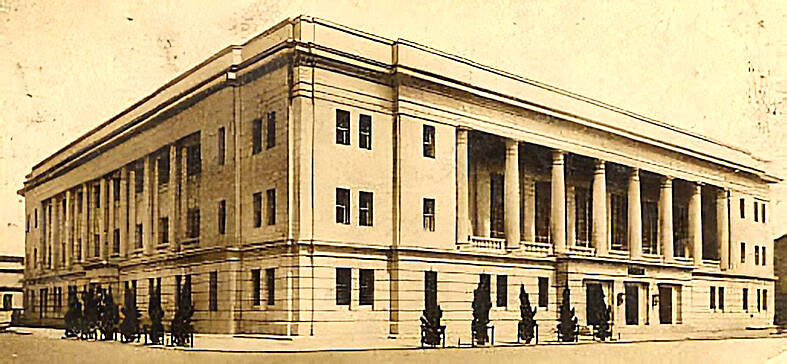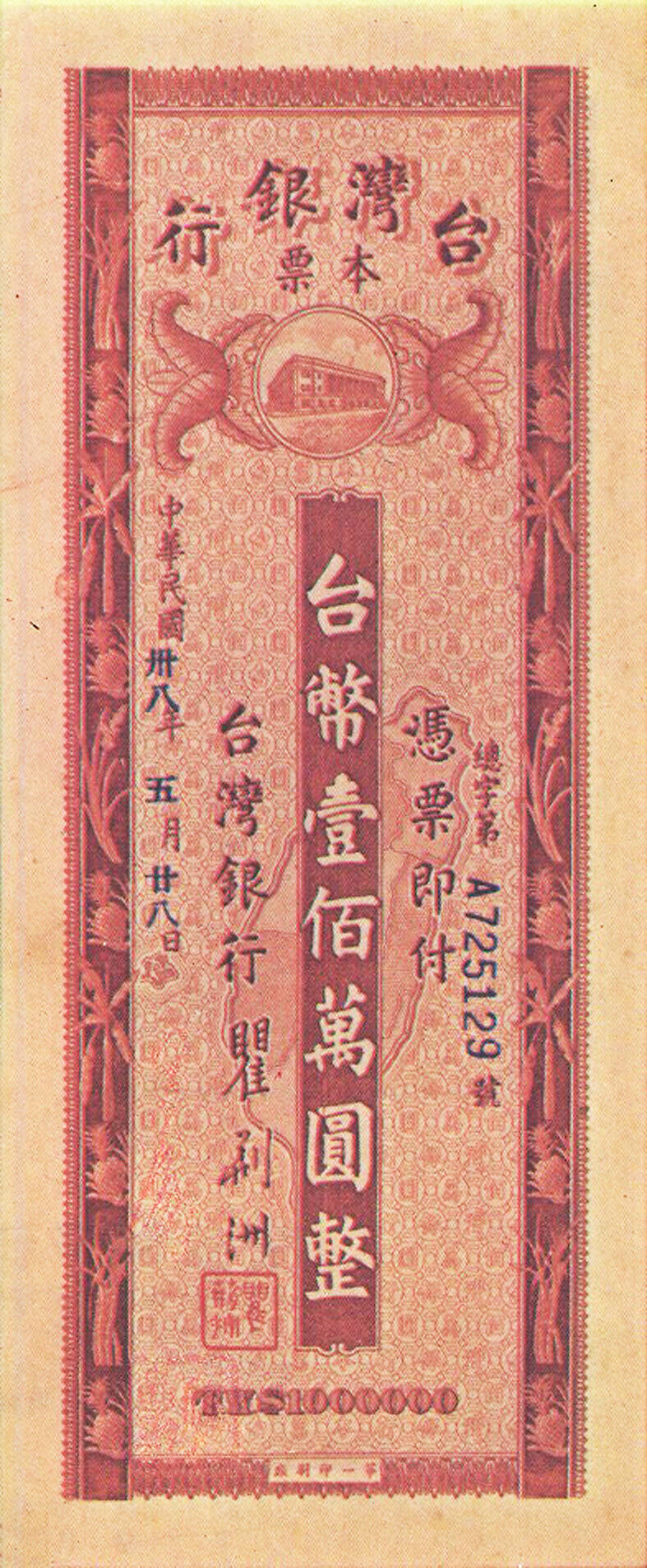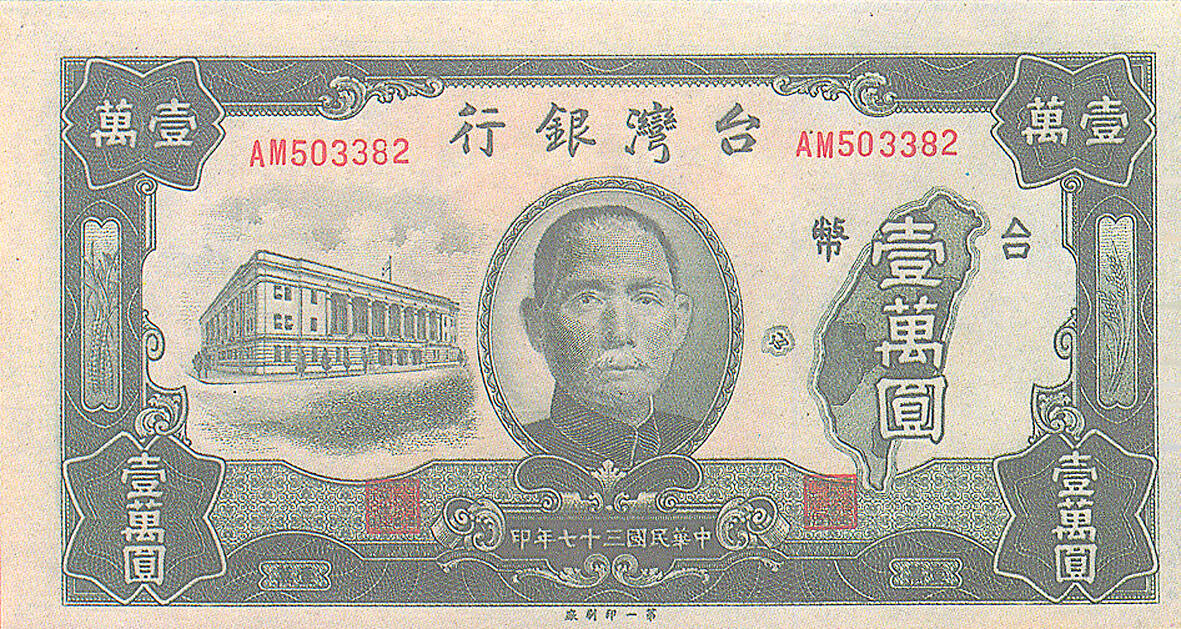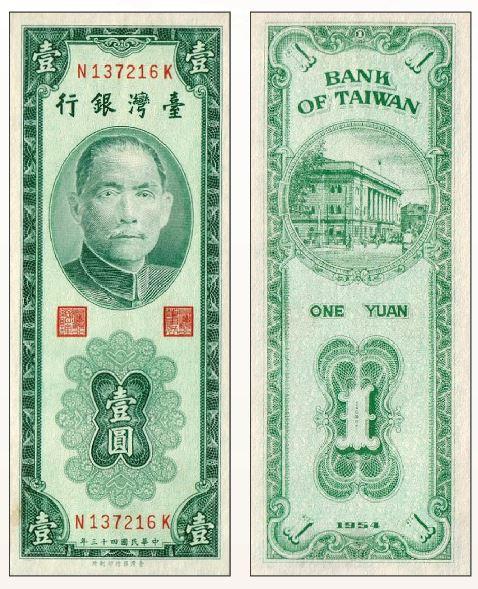June 10 to June 16
The New Taiwan dollar (NTD) was never meant to be the nation’s official currency, and over the decades many questioned why a government that claimed the entire China used it as its de facto national tender. A 1953 United Daily News editorial suggested that it be renamed the “Free China National dollar,” while others urged the government to abolish the “regional” NTD and establish a true national currency.
However, the Chinese Nationalist Party (KMT) could not afford any more massive financial crises that had marred Taiwan and China during the late 1940s. The financial system had finally stabilized with US aid, and they were concerned that any change to the currency would lead people to panic and spark rampant inflation again. They decided to wait for a more opportune time to make the change — preferably after defeating the communists and retaking China.

Photo courtesy of Wikimedia Commons
In the meantime, the legal tender was the silver yuan, which was never circulated in Taiwan. This led to much confusion at first — for example, fees and fines were often posted in silver yuan, and people would think it was NTD and prepare the wrong amount of money.
In 1961, the newly revived Central Bank — which was in charge of issuing the national currency — took over the issuing of NTD from the Taiwan Bank. By this time the NTD was Taiwan’s national currency in all but name only, especially after the 1962 Constitutional Interpretation No. 99 ruled that forging NTD would fall under the Penal Act of Offenses Against National Currency.
Taiwan was no longer at war with the lifting of the Temporary Provisions Effective During the Period of National Mobilization for Suppression of the Communist Rebellion (動員戡亂時期臨時條款) in 1991. The silver yuan was abolished that year, and the nation was actually left without a national currency until the NTD was made official in July 2000.

Photo courtesy of Wikimedia Commons
OLD TAIWAN DOLLAR
The KMT began making plans on how to manage Taiwan’s financial system before the end of World War II. Due to hyperinflation in China, the 1943 “Draft plan for postwar management of Taiwan’s finances” (戰後處理台灣金融方案草) stated that Taiwan should maintain it's independent financial system at least temporarily and have it’s own regional currency, not unlike their plans for Japanese-occupied Manchuria.
The Central Bank and other Chinese banks were to stay out of Taiwan, in order to minimize the impact of the financial chaos in China on Taiwan. At this time, the official currency in Taiwan was the Taiwanese Yen, issued by the Taiwan Bank, which the Japanese colonial government established in 1899.

Photo courtesy of Wikimedia Commons
In the study “From regional currency to national currency: The debate and impact on the status of the Taiwan dollar” (從地方貨幣到國幣 台幣地位相關爭議及其影響), Su Chia-yao (蘇珈瑤) writes that not everyone agreed to this proposal. Finance minister Yu Hung-chun (俞鴻鈞) insisted that the Central Bank take over Taiwanese financial affairs and tried to push through a new scheme, but Taiwan governor-general Chen Yi (陳儀) argued that doing so would lead to inflation, confusion and cause people to lose faith in the government.
In the end, KMT leader Chiang Kai-shek (蔣介石) agreed with Chen, and Taiwan Bank continued to issue temporary Taiwanese bank notes. On May 21, 1946, the bank printed its first Taiwan dollars, today known as Old Taiwan dollars (OTD). The goal was to first phase out Japanese-era money, and when China had stabilized enough, to slowly recall the OTD notes and unify the nation’s currency.
FINANCIAL DISASTER

Photo courtesy of Wikimedia Commons
However, the measures failed as inflation ran wild in Taiwan. Wu Tsung-min (吳聰敏) writes in “Hyperinflation in post-war Taiwan, 1945-1950” (臺灣戰後的惡性物價膨脹) that Taiwanese Yen was already extremely inflated by 1945 due the Japanese over-issuing bank notes to support the war effort. The colonial government had kept things from spiraling out of control by enforcing strict price controls on goods, but that ended when they left.
At first, the OTD was issued in $1, $5 and $10 notes, but $50 and $100 notes were soon added. Despite being financially separate, Taiwan was not immune to the events in China especially as the Chinese Civil War heated up. The KMT’s use of state enterprises in Taiwan and Taiwanese money to support the war, coupled with budget deficits, caused prices to soar and the OTD to decrease in value; by 1948 the bank was printing $10,000 bills and $1 million bearer’s checks. According to a National Development Council document, a kilo of rice cost $1.6 million and one duck egg went for $5,000 at the height of the inflation.
Finally, the government launched the New Taiwan dollar on June 15 1949, at an exchange rate of 40,000 to one. Although this curbed inflation, it greatly affected people’s livelihoods. Goods remained in short supply, and the influx of refugees from China didn’t help. As a result, the government still ended up in the red every fiscal year.

Photo courtesy of Wikimedia Commons
The nation remained in financial trouble until the Korean War broke out in June 1950. To prevent Taiwan from falling to communism, the US started sending aid again. Between 1951 and 1953, more than US$284 million worth of goods and other services came to Taiwan, greatly trimming the national budget deficit.
BECOMING OFFICIAL
The NTD was pretty much stable by 1953. Taiwan Bank had been essentially functioning as the Central Bank since 1949, but due to it falling under the provincial government, it did not have the authority to be a true national bank. The Central Bank was reinstated in 1961, and one of its functions was to oversee the issuing of the NTD — although it was still carried out by Taiwan Bank.
“NTD has been in use in Taiwan for 10 years now, and although there has been slight deprecation, it is an established, trustworthy currency. As of now, it’s unsuitable to replace it, as doing so will cause psychological distress to the citizens,” the official plan stated.
They also noted that having regional currencies would be beneficial in the war to retake China and the subsequent rebuilding effort, and only then would they need to establish a new national currency.
By the 1990s, the government no longer sought to retake China, but now they were still reluctant to make the NTD the official currency as it might suggest Taiwanese independence. These concerns faded over the decade, and in 1998, the Central Bank fully took over the issuing of NTD, redesigning the bills with new graphics and advanced security features, and replacing the words “Taiwan Bank” with “Central Bank.”
The 51-year-old debate finally concluded on Jan. 16, 2000, when the Executive Yuan enacted the Regulations Governing the Issuance of New Taiwan dollars by the Central Bank of China, which clearly states, “The currency of the ROC is the New Taiwan dollar.”
Taiwan in Time, a column about Taiwan’s history that is published every Sunday, spotlights important or interesting events around the nation that either have anniversaries this week or are tied to current events.

Many people noticed the flood of pro-China propaganda across a number of venues in recent weeks that looks like a coordinated assault on US Taiwan policy. It does look like an effort intended to influence the US before the meeting between US President Donald Trump and Chinese dictator Xi Jinping (習近平) over the weekend. Jennifer Kavanagh’s piece in the New York Times in September appears to be the opening strike of the current campaign. She followed up last week in the Lowy Interpreter, blaming the US for causing the PRC to escalate in the Philippines and Taiwan, saying that as

Nov. 3 to Nov. 9 In 1925, 18-year-old Huang Chin-chuan (黃金川) penned the following words: “When will the day of women’s equal rights arrive, so that my talents won’t drift away in the eastern stream?” These were the closing lines to her poem “Female Student” (女學生), which expressed her unwillingness to be confined to traditional female roles and her desire to study and explore the world. Born to a wealthy family on Nov. 5, 1907, Huang was able to study in Japan — a rare privilege for women in her time — and even made a name for herself in the

Would you eat lab-grown chocolate? I requested a sample from California Cultured, a Sacramento-based company. Its chocolate, not yet commercially available, is made with techniques that have previously been used to synthesize other bioactive products like certain plant-derived pharmaceuticals for commercial sale. A few days later, it arrives. The morsel, barely bigger than a coffee bean, is supposed to be the flavor equivalent of a 70 percent to 80 percent dark chocolate. I tear open its sealed packet and a chocolatey aroma escapes — so far, so good. I pop it in my mouth. Slightly waxy and distinctly bitter, it boasts those bright,

“Taiwanese increasingly reluctant to give their lives to defend the island,” trumpeted a South China Morning Post (SCMP) headline last week. The survey asked whether people should be prepared to pay any price — including death — to protect Taiwan and prevent “reunification.” “The poll found that 52.2 percent of those questioned were unwilling to do so — an 8.4-point rise compared with a similar survey carried out two years ago — while 40.8 percent were willing, down four points on the previous survey,” the article said. Treated as anti-Taiwan propaganda, the piece was sent around by the usual pro-China suspects